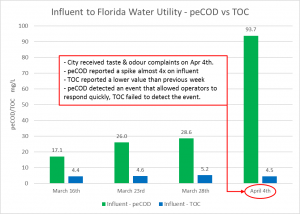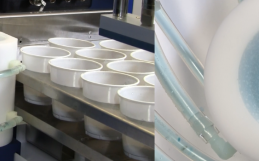A drinking water utility in Florida treats groundwater from an extensive wellfield system containing 48 different wells, as well as surface water from a local creek reservoir. Due to the large number of sources, overall influent quality varies greatly. This presents a need to constantly monitor influent water quality, and use feedback loops to optimize treatment and adequately remove the natural organic matter (NOM). The utility historically has had challenges with taste and odour events as well as elevated Trihalomethanes (THMs). An increase in recent years has identified a deficiency in their source monitoring program.
To address this increasing challenge, the utility has implemented a PeCOD® COD Analyzer to run alongside TOC monitoring the plant influents and point-of-entry. The utility planned a 3-month period to assess the PeCOD® method and compare it to TOC on the ability to help optimize treatment and identify NOM events. A graph showing their results for 4 weeks of testing between March/April is presented below:

peCOD vs. TOC on Influent to Florida Water Utility WTP
On the 4th of April, peCOD spiked to 93.7 mg/L from the previous week’s value of 28.6 mg/L. Comparatively, TOC actually showed a decrease for the week of April 4th. That same day, the city received numerous complaints from residents about taste and odour issues with the tap water. When peCOD recognized the spike, plant operators were able to act quickly to adjust treatment parameters, mitigate the increase in source water reactivity, rectify the taste and odour event, and control THMs within regulatory limits.
Due to the simplicity and relatively low cost of peCOD, water utilities operate the analyzer daily on-site, and send their samples to external laboratories for TOC analysis. The user-friendly PeCOD® COD Analyzer gives them the confidence to fine-tune their processes on a daily basis to account for fluctuating NOM. In addition, they are optimizing and saving the cost of coagulant during times of low NOM concentrations. When NOM spikes do occur, rapid detection by peCOD allows operators to make treatment adjustments, to prevent further taste and odour events and THM spikes.







